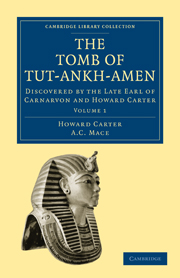Book contents
- Frontmatter
- Preface
- Contents
- LIST OF PLATES
- INTRODUCTION. BIOGRAPHICAL SKETCH OF THE LATE LORD CARNARVON
- CHAPTER 1 THE KING AND THE QUEEN
- CHAPTER 2 THE VALLEY AND THE TOMB
- CHAPTER 3 THE VALLEY IN MODERN TIMES
- CHAPTER 4 OUR PREFATORY WORK AT THEBES
- CHAPTER 5 THE FINDING OF THE TOMB
- CHAPTER 6 A PRELIMINARY INVESTIGATION
- CHAPTER 7 A SURVEY OF THE ANTECAMBER
- CHAPTER 8 CLEARING THE ANTECHAMBER
- CHAPTER 9 VISITORS AND THE PRESS
- CHAPTER 10 WORK IN THE LABORATORY
- CHAPTER 11 THE OPENING OF THE SEALED DOOR
- APPENDIX
- INDEX
- Plate section
- Plate section
CHAPTER 10 - WORK IN THE LABORATORY
Published online by Cambridge University Press: 07 October 2011
- Frontmatter
- Preface
- Contents
- LIST OF PLATES
- INTRODUCTION. BIOGRAPHICAL SKETCH OF THE LATE LORD CARNARVON
- CHAPTER 1 THE KING AND THE QUEEN
- CHAPTER 2 THE VALLEY AND THE TOMB
- CHAPTER 3 THE VALLEY IN MODERN TIMES
- CHAPTER 4 OUR PREFATORY WORK AT THEBES
- CHAPTER 5 THE FINDING OF THE TOMB
- CHAPTER 6 A PRELIMINARY INVESTIGATION
- CHAPTER 7 A SURVEY OF THE ANTECAMBER
- CHAPTER 8 CLEARING THE ANTECHAMBER
- CHAPTER 9 VISITORS AND THE PRESS
- CHAPTER 10 WORK IN THE LABORATORY
- CHAPTER 11 THE OPENING OF THE SEALED DOOR
- APPENDIX
- INDEX
- Plate section
- Plate section
Summary
This chapter is dedicated to those—and they are many—who think that an excavator spends his time basking in the sun, pleasantly exhilarated by watching other people work for him, and otherwise relieved from boredom by having baskets full of beautiful antiquities brought up from the bowels of the earth from time to time for him to look at. His actual life is very different, and, as there can be but few who know the details of it, it will be worth our while to give a general outline here before going into the question of the laboratory work of the past season. Incidentally, it will help to explain why this careful laboratory work was necessary.
In the first place, it must be clearly understood that there is never any question of having basketfuls of objects brought to the excavator for him to look at; the first and most important rule in excavating is that the archaeologist must remove every antiquity from the ground with his own hands. So much depends upon it. Quite apart from the question of possible damage that might be caused by clumsy fingers, it is very essential that you see the object in situ, to gain any evidence you can from the position in which it lies, and the relationship it bears to objects near it. For example, there may very likely be dating evidence.
- Type
- Chapter
- Information
- The Tomb of Tut-Ankh-AmenDiscovered by the Late Earl of Carnarvon and Howard Carter, pp. 151 - 177Publisher: Cambridge University PressPrint publication year: 2010First published in: 1923

